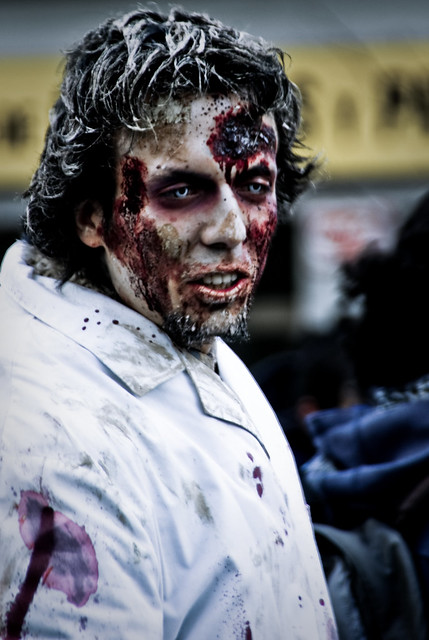Easter Sunday
Solemnity of The Resurrection of the Lord
From Terminals to Transit Centers
Picture: cc abdallahh
Sisters and brothers, do any of you ever ride on our local MTD buses? If you do, you probably know that the bus station is located downtown, on Chapala Street. And you may also be aware that this place is known by a special name. It’s called the Transit Center. Interesting name, don’t you think? I’ve been to other cities where such places are called bus terminals. But is there really any difference between a terminal and a transit center?
Where I come from, the difference is quite large. When I was growing up, it used to be that, if you fell asleep on a bus and didn’t wake up until it reached the end of its route, you would find yourself at a bus terminal. This was usually a lonely place out in the middle of nowhere. For the passengers, this was where their journey was suddenly terminated, where it reached an abrupt end.
Then, as the country began to modernize, these terminals were renovated and renamed. Today people no longer have to stop abruptly at a terminal. Now they arrive at what is called an interchange – which is sort of like a transit center, only bigger. And from here, they can continue on the next stage of their journey by transferring to another bus. Often they can even board a subway train, because the train station is located within the same complex. The bus stations have undergone an important transformation. From terminals – where journeys end – they have been turned into transit centers – places that mark new beginnings. Now that’s quite a big difference, don’t you think?
It is a similar transformation that we are celebrating so joyously on this Easter day. As you have heard, today the action in our readings takes place at the tomb of the crucified Christ. This is the place where the disciples had left the bruised and battered body of their beloved Master. This is the place where they had laid to rest all their hopes and dreams for an earthly king. This is the secluded spot where their journey with Jesus had come to an abrupt and tragic end. The tomb was their terminal.
Yet, even though the tomb was a lonely and desolate place – full of painful memories – something prevented the disciples of Jesus, especially the women, from simply abandoning it altogether. Something drew them back to visit. And it is in this revisiting that an impossible transformation occurs. The place of darkness and death, the place of desolation and despair, is changed into a place of light and life, of consolation and hope. The tomb that once held the corpse of Christ is found to be empty. The stone that sealed the entrance has been removed. And not only are the burial cloths loosened – which once wrapped Jesus tightly in a grip of death – but, seen through the eyes of faith, they are now transformed into signs of a new and indestructible life.
Where once the disciples were fearfully wrapped up in their own grief, gradually they are given the courage and the energy to do what we hear Peter doing in the first reading. They reach out to others, bearing witness to all that Jesus had done and taught. Most of all, they proclaim to everyone the wondrous story of the Lord’s dying and rising. This outward change in their behavior is the result of an inward transformation in their attitude and perception. They are gazing upon the world with new eyes. They are doing what we heard about in the second reading from the letter to the Colossians. They are learning to seek no longer what is on earth but what is above. Having died to their original expectations of an earthly Messiah, who would free them from the Romans, their lives are now hidden with Christ in God. And this radical transformation begins when what at first looked like the end of their journey is changed into the beginning of an exciting new adventure. It begins at the empty tomb, where the terminal is transformed into a transit center.
This is the marvelous change that we are celebrating today. This is the reason for our joy. And we are joyful not only because of what happened to the disciples so long ago. We rejoice because this is also what continues to happen to us even today. On our own life’s journey, perhaps we too have felt as if we had reached a dead end. Perhaps we too have experienced disappointment and despair. Perhaps we too have known the feeling of falling into darkness, of being wrapped in the ghostly grip of death, of being sealed in a cold and clammy tomb.
And, like the disciples, whether it is in our own memories, in our conversations, or in our prayers, we too may have been drawn to revisit the places of our pain, to cry out to God in our anguish. Only to discover – as Mary does, so early on that first Easter morning – that the stone has been rolled away and that the tomb is now empty. There is no longer any reason for us to remain trapped within our loneliness and grief. Although we may still not be able see clearly the face of the Resurrected One, we can already glimpse the hopeful signs of his rising. Like the beloved disciples gazing upon those burial cloths, through the eyes of faith, we can already discern the hand that Christ stretches out to us, calling us to live a new life. We can hear his invitation to us to stop being obsessed with what is on earth, but to set our minds instead on what is above. In this new vision, we find the courage and the strength to continue on our journey, and even to reach out to others, proclaiming to them all that the Lord has done for us. Like the first disciples, we rush off to bear witness, so that others too may join us on the Way.
Sisters and brothers, as we continue to enter into the joy of this Easter season, how is the Risen Lord transforming the terminals of our lives into transit centers today?




